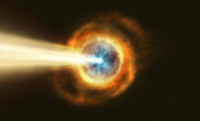RIKEN Research: Thermal electrons play key role in determining emissions from gamma-ray-burst afterglows

he presence of unusually energetic gamma rays seen in some afterglows from intense gamma-ray bursts (GRBs) could be explained by a new mathematical model developed by RIKEN researchers1. This finding could help to shed light on the origin of GRBs.
A GRB is a spectacular eruption of energy produced by violent events such as the explosive death of a massive star, or the collision of two neutron stars. A GRB also shoots a jet of matter and energy into the material that surrounded the star, shocking particles such as protons and electrons and causing them to emit radiation. The emitted photons, ranging from radio waves to gamma rays, can be detected from Earth as a GRB afterglow.
The vast majority of GRB afterglow observations can be explained by current theories, which should come as no surprise: they wouldn’t be the current theories if they didn’t match reality. But the afterglows of two recent GRBs produced gamma rays with unusually high energies that strain these theories. “The surprise with these two bursts was that we had never detected photons this energetic before,” says Donald Warren of the RIKEN Interdisciplinary Theoretical and Mathematical Sciences Program (iTHEMS).
To read more, please visit the related link.
Reference
- Warren, D. C., Dainotti, M., Barkov, M. V., Ahlgren, B., Ito, H. & Nagataki, S., A semianalytic afterglow with thermal electrons and synchrotron self-Compton emission, The Astrophysical Journal 924, 40 (2022), doi: 10.3847/1538-4357/ac2f43

